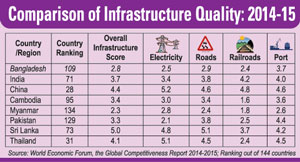
Public expenditure on infrastructure
Zarif Iftekhar Rasul | Friday, 29 May 2015

For a developing country seeking to boost economic growth and development, infrastructure plays a decisive role. The World Economic Forum’s Global Competitive Index (GCI) lists transport and energy infrastructure as a key pillar of competitiveness, highlighting their role as essential elements of the modern production and distribution processes.
The importance of infrastructure to economic growth is reflected not only through infrastructure services entering production as an additional input but also through its contribution in raising total factor productivity by reducing transaction and other costs, thereby allowing a more efficient use of conventional inputs.
Along with directly contributing to a country’s gross domestic product (GDP), it is this resultant increase in productivity that drives the economy forward. The empirical literature report a positive effect of infrastructure on output, productivity and long-term growth rates. Studies have also shown that suboptimal investment in infrastructure constrains other investment, which in turn impedes growth.
Against this backdrop, it is imperative for Bangladesh to sufficiently invest in infrastructure to ensure that all factors facilitating other investment and growth are in place. One of the reasons behind the country’s rapid growth in manufacturing output and employment has been the strong progress with the expansion of exports. Further progress and the ability to develop a diversified export base will require an efficient and low-cost infrastructure system that will strengthen the competitiveness of Bangladeshi exports.
Investing in infrastructure has been a priority for the government. From a low 1.2% of GDP in 2010, spending on infrastructure has steadily increased to 2.1% of GDP in 2015.
Over the past few years, the energy sector, which is a key component of infrastructure, has witnessed solid progress in electricity supply. Total installed power capacity grew at a rate of 18% per year between 2010 and 2015, increasing to 13,540 MW. There has also been remarkable gains in energy efficiency by reducing system loss to 13%.
With financial constraints in the public sector, private sources were mobilized with impressive results – the share of private power in terms of installed capacity rose from 30% in 2010 to 44% in 2015.
However, there are major causes for concern. Much of the additional private electricity comes from rental plants that supply power to the national grid at a high unit cost, resulting in almost a threefold increase in average cost of power generation between 2010 and 2015.
Even with higher bulk average tariff, the selling price of electricity is considerably less than the average cost of production, resulting in huge financial losses and consequent pressure on the national budget. Electricity subsidies increased from Taka 12 billion in 2010 to a staggering Taka 61 billion in 2014, with a projected increase of another Tk 10 billion in 2015 at the time of the previous budget.
The recent downfall in international oil prices will provide some relief to the upcoming budget. In light of the severe gas-supply constraint and plans to import energy, energy pricing issues, however, will continue to pose substantial challenges for the budget. It is therefore essential to maintain a realistic balance between energy subsidies and budgetary discipline.
Moving over to the transport sector, the progress has been relatively weak compared to that of the energy sector. Against the desired growth rate of 7.5% under the Sixth Five Year Plan, the transport sector has grown, on average, by 6.2% over the last five years. Construction of new roads and road improvements have been marred by slow progress, with capacity constraints delaying the completion of many projects.
The roads and railways sectors, despite having received a significant amount of resource allocation under the Annual Development Programme (ADP), continue to spend well below their budgetary outlay. The sheer number of projects under implementation (the Roads Division has 156), coupled with a lack of prioritization, strains the implementation capacity. Construction of bridges, tunnels, and other physical infrastructure has suffered the same fate. Notwithstanding the target of deficit-free operation of Bangladesh Railway by 2015, it continues to operate on a loss currently amounting Tk 8.41 billion (841 crore).
Amidst this rather bleak infrastructure scenario, how does Bangladesh fare with comparable countries? According to the GCI (Table 1), although overall infrastructure has improved in Bangladesh between 2010 and 2015, the country still lags behind its comparators.
Bangladesh has a low score of 2.8, well behind India and Sri Lanka with scores of 3.6 and 4 respectively. The gap is much larger when compared to countries like China and Thailand.
The electricity sector received a score of 2.5, only ahead of Pakistan. Roads and railroads are also characterized by low scores. Although there have been improvements in electricity, railroads and ports (with a slight decline in the score for roads), the low scores are indicative of the low level of infrastructure in the country.
Given the current scenario, infrastructure development is a challenge that needs to be pursued with prudent financial strategies. In the past few budgets, energy and transport have been among the focal points, with growing expenditure allocations as a share of GDP.
This encouraging trend should be maintained in the 2016 budget while addressing pricing and subsidy issues in the energy sector. The transport sector also needs a revamp, including prioritization of projects, in order to transform the current physical infrastructure into a more efficient one.
It is expected that a low-cost infrastructure system will not only sustain the country’s competitiveness in the world market, but will also help bring into fruition the vision of accelerated growth.
[The writer is Economist, Policy Research Institute (PRI). The Financial Express (FE)-PRI Economic Analysis Unit (EAU)]